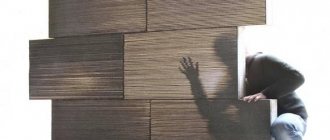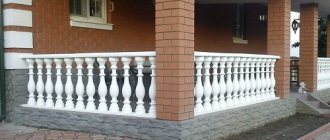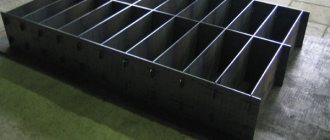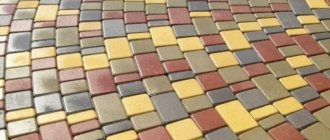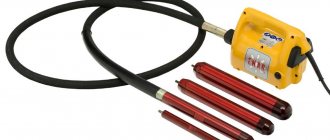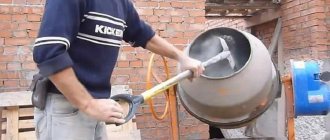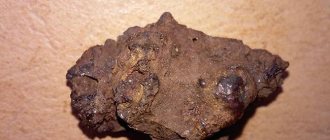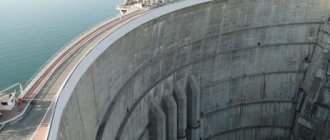ASG is a construction mixture that contains two separate components: sand and gravel. Therefore, it has a unique set of properties and qualities inherent both to the entire mixture as a whole and to its individual parts.
Therefore, PGS is assessed according to three parameters:
- According to general indicators characteristic of the entire mixture
- In terms of sand component
- In terms of gravel component
Below we will talk in detail about each.
Species diversity of PGS
ASG for concrete or sand-gravel mixture, depending on the ratio of the components, comes in only two types. The first, classic version of the composition contains approximately 80% sand and only 20% gravel component. The second type of ASG consists of ¾ gravel.
This mixture is artificially enriched using special screens and other special equipment, which helps remove excess sand and regulate the volume of gravel.
Similar compositions are also divided by place of origin:
- Marine - characterized by the content of rounded gravel particles and the extreme strength of the rock. It is not so common on the building material market - it depends on the region, and usually they are characterized by an increased price.
- Lake-river ones are characterized by the presence of not only smoothly shaped gravel, but also a small presence of shell rock and clay. The latter, as is known, does not have a very good effect on the quality of concrete.
- Mountain-gully mixtures can be distinguished by the presence of needle-shaped gravel and a higher concentration of foreign inclusions.
Attention! Due to this composition, the mountain-ravine mixture is not used for the production of concrete, since the high content of impurities sharply reduces its quality. But such ASGs are practically irreplaceable when backfilling trenches, highways, and other things.
To obtain working solutions, mainly lake-river mixtures are used. In the case when it is necessary to create high-strength concrete based on ASG, then its marine type is used. But be quite careful, because in a separate form, crushed stone and sand are much more reliable as fillers.
Peculiarities
One of the reasons why the use of PGS demonstrates such high rates is due to some of its features. They are associated with the use of the mixture in construction. We have highlighted a few of them:
- Versatility. ASG is used everywhere in construction. This means that it can be used for various purposes, and not just to perform a specific task (we have given examples below.
- Safety. Since it is made from natural ingredients, it can be called a completely environmentally friendly composition.
- Storage. The mixture can be stored for a very long time. In addition, the conditions are very simple: the room must be dry. If moisture gets in, you can compensate for this fact by adding a smaller amount of water during the manufacturing process of the composition.
- Persistence. This is one of the most resistant resources to low and high temperatures. In addition, it is able to demonstrate its strength even under heavy loads.
- Price. PGS can be called an inexpensive material, especially if you purchase its natural analogue.
People encounter other features while working with the composition. As a rule, there are no obvious and radical shortcomings. Especially if the number of large particles and their sizes do not exceed the norm.
Which sand and gravel mixture is better to choose?
When selecting an ASG for concrete work, they are guided not only by its type. The grain composition also plays an important role. According to GOST 23735–2014, mixtures are classified according to size into 6 groups.
Table of particle size of ASG components
OPGS is also classified into groups, but not by the total size of the components, but by the percentage of gravel as the main component. A total of 5 groups were identified, which are also reflected in GOST 23735–2014.
In the photo above, the crushed stone size values in OPGS
The size of the gravel aggregate, according to the technical documentation, should not be more than 10, 20, 40 and 70 mm, respectively, by group. However, in rare cases, grain sizes up to 150 mm are allowed.
Like crushed stone, ASG components must also meet certain standards for basic quality characteristics, such as frost resistance, strength and dust resistance. Similar values are recorded in GOST 8267–93. This document regulates the normative characteristics of the sand included in the mixture.
Which type of ASG to use for preparing concrete depends on the project assignments. If there is no such thing, and there is a choice, then it is better to make it in favor of an enriched mixture.
Ideally, the composition should be as follows:
- Conventional concrete work – gravel up to 80 mm in size;
- Production of reinforced concrete (not factory products) – gravel with a diameter of up to 30 mm;
- For foundations - sand with a particle size of 5 mm from 30 to 45% and gravel with a diameter of 5-70 mm 55-70%.
Particular attention should be paid to the content of contaminants in the sand - the less, the better. In order not to guess and not once again order the services of a construction laboratory, you can determine a small test for ASG contamination yourself.
In addition, approximately the same method is used by laboratory technicians:
- Step 1. Take a 5-liter bottle of water, where a good guest of the composition is added.
- Step 2. Intensive shaking is performed.
- Step 3. The bottle is left alone for about a day, after which they look at the color of the water. If it is just a little cloudy, then the content of pollutants is minimal, which is quite acceptable - otherwise it is better to refuse to use the mixture.
It is better to take care of the quality of concrete in advance than to redo everything later. And remember, the miser pays twice!
Production process
The production of natural and enriched ASG is different. In the case of a natural mixture, the process is carried out in accordance with the following steps:
- Soil analysis. The rock volume is determined. At the same time, it is important to assess the damage that could be caused to nature if production starts in a given deposit.
- Reservoir development. You can use excavators or the hydromethod. The first option is most often used, since it requires less attention during the work process.
- Extraction. Excavators of various types are engaged in the extraction of raw materials;
- Sorting. If the material was raised from the bottom of the river, it must first be dried. In addition, it is important to remove large particles from any raw material. Then it is moved to special rooms where it is stored.
Approximate proportions of concrete at ASG
Concrete on OPGS is a “star” in the field of driving foundations. Therefore, let’s consider how much ASG is in 1 m3 of concrete, which is produced in several grades:
- M150 is applicable for the bases of small, mansard-free, one-story buildings, usually for utility purposes;
- M200 is indispensable when driving tape or slab foundations under one-story houses;
- M250 is more often used for monolithic foundations, although according to the project, strip foundations of a similar grade of concrete can also be laid;
- M300 – for slab foundations of private buildings, two or more floors high;
- M400 is used when constructing a particularly strong base or base, which requires early setting and strength gain.
The preparation of concrete from ASG does not tolerate the use of binder grades below M300 and additives of more than 20%. It's best without them. Below are the approximate mixture proportions.
Concrete proportions and amount of cement
Attention! Adjustment of the composition before launching it into mass production is mandatory, as well as testing the quality characteristics of the resulting concrete. The number of components depends on the quality of the components used.
Cost of PGS for road surface
Natural mixtures that can be used for filling roadsides are relatively inexpensive: you can find offers in the range of 200-350 rubles per kg. Enriched ASG can cost twice as much.
©gipsokart.ru
More articles
- Plasterboard finishing of attics
- Knauf is the largest manufacturer of plasterboard
- Flooring for home and office
- Periodic cleaning of the heating boiler
- Laser cutting of sheet metal
- What is Riphean Line
- Current repairs of the roof of a private house
Technology for preparing concrete using a sand-gravel mixture
Concrete using ASG, just like the classic mixture using standard aggregates, is produced “in the field” by hand and using a standard concrete mixer. The brief instructions below will tell you how to do it yourself.
Preparing the Main Components
The first thing you need to know and be prepared for is that the aggregates that have them will have more moisture than required (for example, after rain). In this case, adjustment of the amount of water is required. It's easy to do.
First, only 2/3 of the required volume of liquid is taken and added to the dry ingredients. After thorough mixing, more water is added little by little until a homogeneous mixture of a consistency normal for the work being carried out is obtained.
Manual mixing of concrete is carried out in several stages:
- Step 1. Most of the cement and the entire volume of OPGS are poured into the prepared container (or simply onto a flat area), and mixed thoroughly. After which the remaining binder is dosed and mixed until smooth.
Mixing components
- Step 2. A low slide is formed from the resulting dry mixture, in the middle of which a small depression is made.
Water dosing
- Step 3. Water is dosed into the funnel according to the above principle, while the solution is thoroughly mixed with shovels until homogeneity and a “good” consistency are obtained.
Mixing in a concrete mixer is done according to a slightly different principle:
- Step 1. Turn on the empty mixer in the first position, after which the first part of the water is dosed.
- Step 2. Fill in the entire volume of the OPGS and swirl with water for a couple of minutes.
- Step 3. The mixer is moved to the second position and all the cement is dosed.
- Step 4. While mixing, dose the remaining water until a homogeneous mixture is obtained.
Be careful and compare the actual volume of your mixer and the amount of ingredients. The video in this article explains how to do this, as well as the nuances of the technology for the automated method of preparing concrete using OPGS.
To summarize, we can say that ASG concrete for fundamental and other work on a construction site is an excellent alternative to the classic mixture using expensive conventional aggregates. The downside is that not all companies work with ASG. Therefore, it is necessary to resolve this issue in advance in order to competently plan construction work on the site.
Scope of application and technical requirements for ASG
The most common analytical instruments that determine the composition of the gas environment with high accuracy are chromatographs, gas analyzers, and gas sensors installed in premises. However, in order for the reliability of their readings to be at the appropriate level, it is necessary to carry out periodic verification using certified mixtures.
The main technical requirements for test gas mixtures include: accuracy of the composition, which must remain constant for a given period; complete absence of harmful impurities. To ensure the required purity, initial components (argon, nitrogen, oxygen, hydrogen, neon and others) with a content of foreign impurities from 0.001% to 0.01% are used.
It is difficult to overestimate the importance of ASG for gas producers. Before providing the consumer with its products, the supplier must ensure its quality, for which laboratory control is carried out using, for example, chromatography. To obtain reliable results, the chromatograph must be properly calibrated with a reference substance. You can read more about laboratory gas testing here.
USSR educational film:
